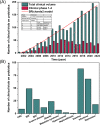Probiotics, prebiotics, and postbiotics in health and disease
- PMID: 37929014
- PMCID: PMC10625129
- DOI: 10.1002/mco2.420
Probiotics, prebiotics, and postbiotics in health and disease
Abstract
The gut microbiota and its homeostasis play a crucial role in human health. However, for some diseases related to the gut microbiota, current traditional medicines can only relieve symptoms, and it is difficult to solve the root causes or even cause side effects like disturbances in the gut microbiota. Increasing clinical studies and evidences have demonstrated that probiotics, prebiotics, and postbiotics can prevent and treat various diseases, but currently they can only be used as dietary supplements rather than medicines, which restricts the application of probiotics in the field of medicine. Here, this review analyzes the importance of gut microbiota in human health and the current problems of traditional medicines, and systematically summarizes the effectiveness and mechanisms of probiotics, prebiotics, and postbiotics in maintaining health and treating diseases based on animal models and clinical trials. And based on current research outcomes and development trends in this field, the challenges and prospects of their clinical application in maintaining health, alleviating and treating diseases are analyzed. It is hoped to promote the application of probiotics, prebiotics, and postbiotics in disease treatment and open up new frontiers in probiotic research.
Keywords: clinical trials; gut microbiota; postbiotics; prebiotics; probiotics.
© 2023 The Authors. MedComm published by Sichuan International Medical Exchange & Promotion Association (SCIMEA) and John Wiley & Sons Australia, Ltd.
Conflict of interest statement
The authors declare that there are no conflict of interest.
Figures





References
-
- Gomaa EZ. Human gut microbiota/microbiome in health and diseases: a review. Antonie Leeuwenhoek. 2020;113(12):2019‐2040. - PubMed
Publication types
LinkOut - more resources
Full Text Sources
